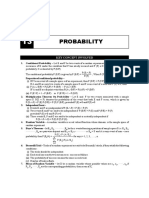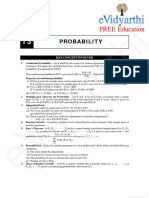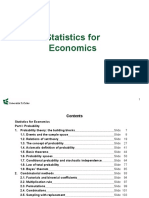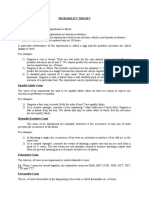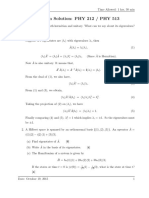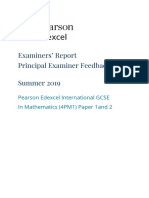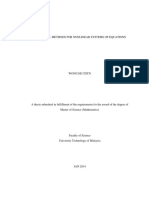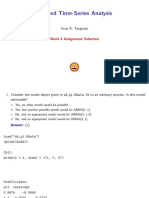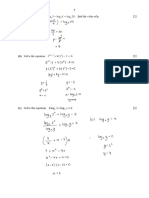PROBABILITY
Probability 2 Random Experiment
If an experiment results in a total of (m + n)outcomes which are An Experiment caled random experiment the following
n is it satisfies
if
equally likely and if
'm' outcomes are favourable to event A' two conditions:
while 'n'are unfavorable, then the probability of occurrence of the It has more than one possible outcome.
1.
event 'A denotedby P(A), is defined by 2. It is not possible in advance.
to predict the outcome
number of favourable outcomes Outcome: A possible result of a random experiment is called its
its outcome.
PA) = Sample Space:Set of all possible outcomes of aatrandom experiment is
+7 total number of outcomes olled sample space. lenoted by symbol's:.
3 Algebra of Events
4 Types of Events
Event A or B or AUB={w:w eA or w eB)
1. Impossible and Sure Event: The empty set is called an
Event A and B or AnB={w: w eA and w eB) impossible event, where as the whole sample space'S
is called 'Sure event'.
Event A but not B or A-B=AnB
2. Simple Event: an event has only one sample point of a sample
If
space, it is calleda 'simple event!
5 Probabilityof AUB, An Band P (notA) 3. Compound Event: an event has more than one sample point,
If
iscalled a'compound event'.
it
A andB are any two events, then
If
P(ALB) = P(A) +P(B) - P(AnB) 4. Complementary Event: Complement event to A = not A'
P(AnB) =P(A) + P(B)-P(AUB) 5. Exhaustive Events: Many events that together form sample
space are called exhaustive events.
If A and B are mutually exclusive, then P(AUB) =P(A)+P(B)
6. Mutully Exclusive: A & B are called mutualy exclusive
Events
Probability of the event 'not A' events it occurrence any one of them excludes occurrence of
of
P(A') = P(not A) 1- P(A) = other event, i.e. they cannot occur simultaneously.
7. Mutually exclusive and exhaustive: The events which are not
mutually exclusive are known as compatible events or mutually
non exclusive events. Mutually exclusive and exhaustive system
BE B-A of events: Let S be the sample space associated witha random
experiment. Let .
A,A, An be subsets of S such that
AnB )AnA= jand
,
for
i
Then, the collection of events A, A, An is said to form a
mutually exclusive and exhaustive system of events.
Conditional Probability
8. Independent Events
E and F are two events associated with the sample space of a random )ifE&F are independent, then
If
experiment, the conditional probability of the event given that it has
Occured is given as:
(P(EnF)= P(F)P(E/F) = P(E), P(F)=OP(F/e) = P(F),P(E)=o)
PE/F) EOF)_EnF) , P(F) 0 ()Three events A,B&Care said to be mutually independent, if
P(F) nF)
(e(ane) =P(AJP(B), P(Anc) = P(A)P(c), P(8nc)= P(B)P(C) &
Properties of Conditional Probability P(AnBnC)=P(A)P(B)P(c))
Let E & F be events sample space of an experiment,
of then we have
we
1.
If at least one of the above isnot true for three given events,
P(S/F)= P(F/F) =l
say that the events are not independent.
2. If A and B are any two events of a sample space S & Fis an event of
such that
P(F) =0,then P(A/F)+PB/F)- P((An
In particular
P((A UB)/FJ=
A and B are disjoint events, then
B)/F)
9 Baye's Theorem
if
P(AUB)/IE) =P(A/F)+ P(B/F)
3.P(E/Fj=|-P(E/F)
Partition of a Sample Space
A set of events E,,E,..E, is said to represent a partition of
Multiplication Theorem
7 the sample space S
it
On Probability (o) E,nE, =4,i* j.i,j= 1,2,3,...n
(6) E,UE, U...UE, =S
For two events E & Fassociated with a sample spaceS,we have
(PENF)=PE)PE/E) =PF)PEF) (c)P(E)>0 for = 1,2,...n
al
provided P(E)=0 & P(F)=0 Theorem of Total Probability. Let (E,E,,..E.)
The above result is known as Multiplication Rule of Probability.
be a partition of the sample space S
and suppose that each of the events E,, E,...E,
has nonzero probability
be any event associated with S then
8 TotalProbabilityTheorem
of occurence. Let A
RA)-PE)"{A/E )
an even A can occur with one
n mutually exclusive and
of the
If
exhaustive events B, B, Bn and the probabilities Bayes Theorem: E, E,E, are non-empty events which constitute a
If
P(A/B), P(A/B,) P(A/B) are known, then partition of sample
space S &A is any event of non- zero probability.
P4-MPAIA) P(E,I4)==
P(E)P(41E) for any =1,2,3,...,n
i
S(s)P(a1E,)
� Random Variable& Its
10
Probability Distributions
11 Mean Of A Random Variable
A random variableis a real valued functionwhose domain
is the sample space oof probability
The mean () of a random variable X is also called the expectationof
istribution
dist
of orndo
a
The
X denoted by E(X)
X:x, x,
E(X)-xp
P(X): P P: * P
Here ,,x,.., x,are possiblevalues of random variable
where, P, > O,p,= l,i=1,2,..,.n X, occuring with probabilities P,-P..P, respectively.
The realnumbers x,, X,,...,X,are the possible values
12 Variance of Random Variable
of the random variable X and P,(i=1,2.,...,n)
is the probability of the random variable ie, Let X be a random variable whose possiblevalues X,, X, ...,x, ,
occur with probabilities p(x,).p(x,)..p(x,)respectively.
Also let
P(X=x)=P,
u= E(X) bethe mean ofX then the variance of X is given as:
VaX) oroi--0nx)EX-u E(X-[EX)
The non-negative number a,=/Var(X) is called the Standard
Deviationof random variable X
13 Bernouli Trials & Binomial Distribution
Bernoulli Trials:
Trials of a random experiment are called Bernoulli trials, if they satisfy thefollowing conditions:
|)There should bea number finite of trials.
) The should be independent.
trials
Each trial has exactly two outcomes: success or failure
(iv) The probability of success renains same in each trial.
Distribution:
inomial distril
probability ribution of number of successes in an experiment consisting of n Bernoulli trials may be obtained by the binomial expansion
q p)where p is probability of success in each trial andp+q=l. Hence, this distribution (also called Binomial distribution Bn,p) of number
of successes X can be written as:
P() "Cq'p
2
|Cp C.p
The probobility of X successes P(X ) is also denoted by P(x) is given as:
P(x) =* Cqp',x =0,1, *",n (q=1-p)
This P(x)is called the probability functionof thebinomial distribution.


